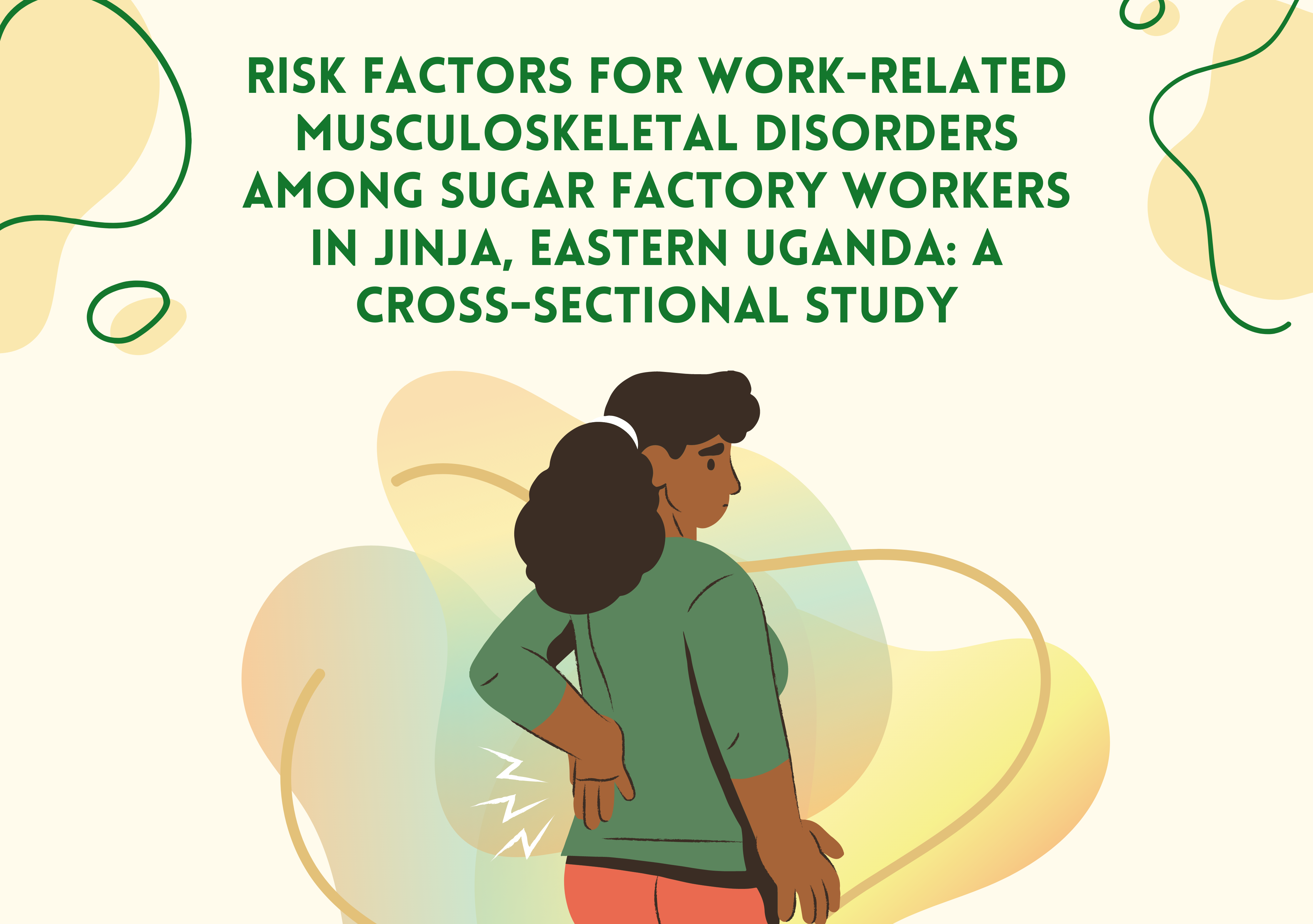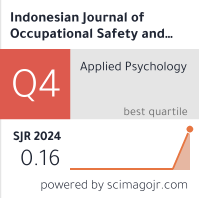Risk Factors for Work-related Musculoskeletal Disorders among Sugar Factory Workers in Jinja, Eastern Uganda: A Cross-Sectional Study

Downloads
Introduction: The disease outcome of musculoskeletal disorders includes; serious occupational disorders and disabilities that are associated with the loss of useful working days and socioeconomic burden to the individual, the organization, and society at large. The aim of this study is to determine the work-related musculoskeletal disorders and associated risk factors among sugar factory workers. Methods: The cross-sectional study design was employed in this study in the workplace among 402 workers between two sugar factories. The self-structured Standardized Nordic Musculoskeletal Disorders questionnaire was administered. Data were analysed into descriptive statistics, binary logistic, and multiple logistic regression using SPSS vs. 26. Results: The results indicate that the prevalence of work-related musculoskeletal disorders in the previous 12 months among sugar factory workers was 53%. The Lower back region has the highest prevalence of 52.2% and the lowest prevalence of 12.7% on Neck region. The following highlighted factors were significantly associated with the reporting of WRMSD among sugar factory workers during the last 12-months, such as; age of the respondents, educational status, work designation, monotonous task, standing for long periods, and time taken to carry out the task. Conclusions: Workers in sugar factories are constantly exposed to ergonomic hazards which predisposed them to WRMSD. If these situations are not prevented it might worsen the burden of WRMSDs among workers, result in cases of more absenteeism and low productivity.
Amin, N. A. et al. (2016) ‘Work Related Musculoskeletal Disorders in Female Nursing Personnel: Prevalence and Impact', International Journal of Collaborative Research on Internal Medicine & Public Health, 8(3), pp. 294–315.
Amiri, F. et al. (2020) ‘Examination of Work-Related Musculoskeletal Disorders and Their Related Factors among Farmers of Asadabad City in 2015', Pharmacophore, 11(1), pp. 52–57.
Anap, D. and Vasave, S. Y. (2016) ‘Prevalence of Musculoskeletal Disorders among Sugarcane Workers – A Cross- Sectional Study', Indian Journal of Basic and Applied Medical Research, 5(4), pp. 752–758.
Ayanniyi, O., Nudamajo, O. and Mbada, C. (2016) ‘Pattern of Work-Related Musculoskeletal Disorders Among Nigerian Hospital Workers', Journal of Environmental and Occupational Science, 5(1), pp. 18–24.
Babantunde, A. A. et al. (2022) ‘Musculoskeletal Disorders among Sugar Factory Workers in Jinja-Uganda: A Cross-Sectional Study', Journal of Musculoskeletal Disorders and Treatment, 8(1), pp. 1–10.
Babatunde, A. A. and Olaniyan, L. T. (2017) ‘Prevalence and Factors Associated with Low Back Pain among Healthcare Workers in Kibuli Muslim Hospital Kampala, Uganda', Epidemiology, 07(01), pp. 1–5.
Baxi, M. S., Sant, S. S. and Hande, D. N. (2016) ‘Prevalence of Musculoskeletal Disorders among Sugar Factory Workers of Loni: An Ergonomic Study', IOSR Journal of Nursing and Health Science, 5(5), pp. 86–90.
Biswas, G., Bhattacharya, A. and Bhattacharya, R. (2017) ‘Work-related Musculoskeletal Disorders: A Case Study among Male Molasses Workers in Nadia District of West Bengal, India', International Journal of Medical Science and Public Health, 6(12), pp. 1706–1712.
Black, T. R. et al. (2011) ‘Effect of Transfer, Lifting, and Repositioning (TLR) Injury Prevention Program on Musculoskeletal Injury among Direct Care Workers', Journal of Occupational and Environmental Hygiene, 8(4), pp. 226–235.
Brown, N. P. et al. (2020) ‘Development of a Canine Rigid Body Musculoskeletal Computer Model to Evaluate Gait', Frontiers in Bioengineering and Biotechnology, 8(March), pp. 1–16.
Chandrasekara, U. H. S., Warnakulasuriya, S. S. P. and Kisokanth, G. (2020) ‘Prevalence of Musculoskeletal Pain and Environmental Health Hazards among Tea Pluckers of Maddekanda Tea Estate in Balangoda Pradeshiya Saba Division, Sri Lanka', Journal of Public Health Research, 9(4), pp. 404–409.
Cieza, A. et al. (2020) ‘Articles Global Estimates of the Need for Rehabilitation based on the Global Burden of Disease Study 2019: A Systematic Analysis for the Global Burden of Disease Study 2019', The Lancet, 396(10267), pp. 2006–2017.
Dehghan, N. et al. (2016) ‘The Effect of a Multifaceted Ergonomic Intervention Program on Reducing Musculoskeletal Disorders in Dentists', Medical Journal of the Islamic Republic of Iran, 30(472), pp. 1–5.
Dianat, I. et al. (2020) ‘Work Posture, Working Conditions and Musculoskeletal Outcomes in Agricultural Workers', International Journal of Industrial Ergonomics, 77, pp. 1–9.
Elfil, M. and Negida, A. (2019) ‘Sampling Methods in Clinical Research; an Educational Review', Archives of Academic Emergency Medicine, 7(1), pp. e52–e55.
George, D. and Mallery, P. (2019) IBM SPSS Statistics 26 Step by Step : A Simple Guide and Reference. New York: Routledge.
Grove, S. K. and Gray, J. (2018) Understanding Nursing Research: Building an Evidence-Based Practice. 7th Editio. United State: Saunders.
Husky, M. M. et al. (2018) ‘Chronic Back Pain and its Association with Quality of Life in a Large French Population Survey', Health and quality of life outcomes, 16(1), p. 195.
Iti, J. L., Nigudgi, S. R. and Reddy, S. (2016) ‘Assessment of Musculoskeletal Disorders by Standardized Nordic Questionnaire among Computer Engineering Students and Teaching Staff of Gulbarga City', International Journal of Community Medicine and Public Health, 3(3), pp. 668–674.
Jain, R. et al. (2018) ‘Risk Factors for Musculoskeletal Disorders in Manual Harvesting Farmers of Rajasthan', Industrial Health, 56(3), pp. 241–248.
Jay, K. et al. (2018) ‘Fear Avoidance Beliefs and Risk of Long-Term Sickness Absence: Prospective Cohort Study among Workers with Musculoskeletal Pain', Pain Research and Treatment, 2018(10), pp. 1–6.
Karkousha, R. N. and Elhafeza, H. M. (2017) ‘Relation between the Prevelance of Work-Related Musculoskeletal Disorders and Years of Job Experience among Workers of Nag Hammadi Sugar factory in Egypt', Bulletin of Faculty of Physical Therapy, 22, pp. 23–26.
López-Aragón, L. et al. (2017) ‘Applications of the Standardized Nordic Questionnaire: A Review', Sustainability (Switzerland), 9(9), pp. 1–42.
Moodley, R. and Naidoo, S. (2015) ‘The Prevalence of Musculoskeletal Disorders among Dentists in KwaZulu-Natal', South African Dental Journal, 70(3), pp. 98–103.
Munabi, I. G. et al. (2014) ‘Musculoskeletal Disorder Risk Factors among Nursing Professionals in Low Resource Settings: A Cross-Sectional Study in Uganda', BMC Nursing, 13(7), pp. 1–8.
Nilvarangkul, K. et al. (2018) ‘Development and Validation of a Work-Related Low Back Pain Risk-Assessment Tool for Sugarcane Farmers', Industrial Health, 56(4), pp. 320–326.
Pawar, P. V. et al. (2019) ‘A Study to Find Impact of Work Duration on Health in Sugarcane Factory Workers.', Biomedical Research (Japan), 30(4), pp. 524–528.
Phajan, T. et al. (2014) ‘Work-related Musculoskeletal Disorders among Sugarcane Farmers in North-Eastern Thailand', Asia-Pacific Journal of Public Health, 26(3), pp. 320–327.
Ramdan, I. M., Wiranto, A. and Candra, K. P. (2019) ‘Correlation Power of Related Factors Affected Musculoskeletal Disorders Complaints Amongst Rice Mill Unit Operators', Asian Journal of Epidemiology, 12(2), pp. 45–52.
Sarma, K. V. S. (2019) ‘Sample Size Determination in Clinical Research – Perceptions and Practice', in 21st Annual Conference of SSCA, pp. 93–99.
Singh, V. et al. (2015) ‘Upper Limb Musculoskeletal Disorders Associated with Computer usage in Health-Care Professionals', International Journal of Medical Science and Public Health, 4(11), pp. 1615–1619.
Sites, B. D. et al. (2018) ‘Prescription Opioid use and Satisfaction with Care among Adults with Musculoskeletal Conditions', Annals of Family Medicine, 16(1), pp. 6–13.
Skillgate, E. et al. (2009) ‘Is Smoking and Alcohol Consumption Associated with Long-Term Sick Leave Due to Unspecific Back or Neck Pain among Employees in the Public Sector? Results of a Three-Year follow-up Cohort Study', Journal of Rehabilitation Medicine, 41(7), pp. 550–556.
Woolf, A. D. (2015) ‘Global Burden of Osteoarthritis and Musculoskeletal Diseases', BMC Musculoskeletal Disorders, 16(S1), p. 1.
World Health Organization (2017) Guidelines on Community-Level Interventions to Manage Declines in Intrinsic Capacity, World Health Organization. Genva: World Health Organization.
WRMSDs Great Britain (2021) ‘Work-related musculoskeletal disorders statistics in Great Britain, 2021', Hse.Gove.Uk, (March), pp. 1–22.

This work is licensed under a Creative Commons Attribution-NonCommercial-ShareAlike 4.0 International License.

In order to be accepted and published by The Indonesian Journal of Occupational Safety and Health, Author(s) who submit an article should complete all the review process. The copyright of received articles assigned to the The Indonesian Journal of Occupational Safety and Health and Department of Safety and Health, Universitas Airlangga as publishers of the journal. The intended copyright includes the rights to publish articles in various forms (including reprints).
The Editorial Team of The Indonesian Journal Of Occupational Safety and Health and Department of Safety and Health strive to ensure that no errors occur in the articles that have been published, both data errors and statements in the article.
Users of this website will be licensed to use materials from this website following the Creative Commons Attribution-NonCommercial-ShareAlike 4.0 International License. No fees charged. Please use the materials accordingly.
------------------------------------------------------------------------------------------------------------------------------------------------------------------------------------------
Attribution ” You must give appropriate credit, provide a link to the license, and indicate if changes were made. You may do so in any reasonable manner, but not in any way that suggests the licensor endorses you or your use.
NonCommercial ” You may not use the material for commercial purposes.
ShareAlike ” If you remix, transform, or build upon the material, you must distribute your contributions under the same license as the original.







 How to Submit Articles in OJS
How to Submit Articles in OJS

























